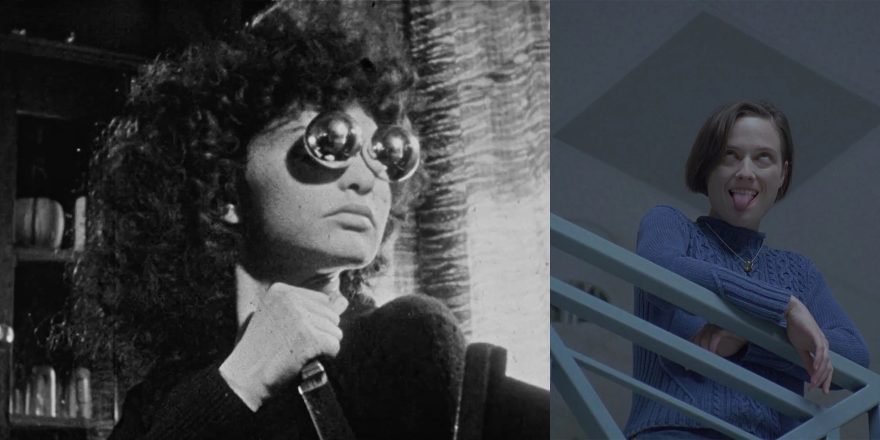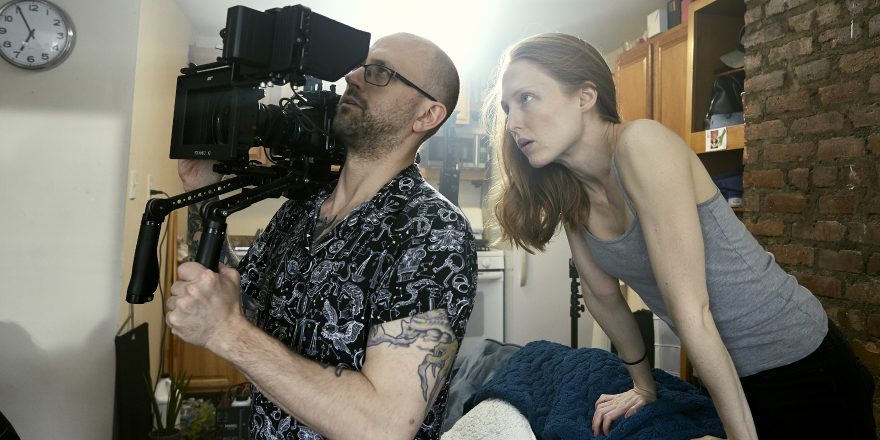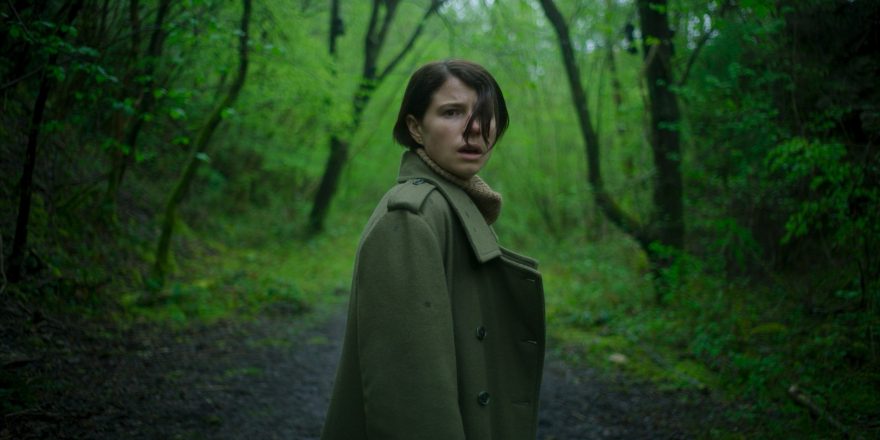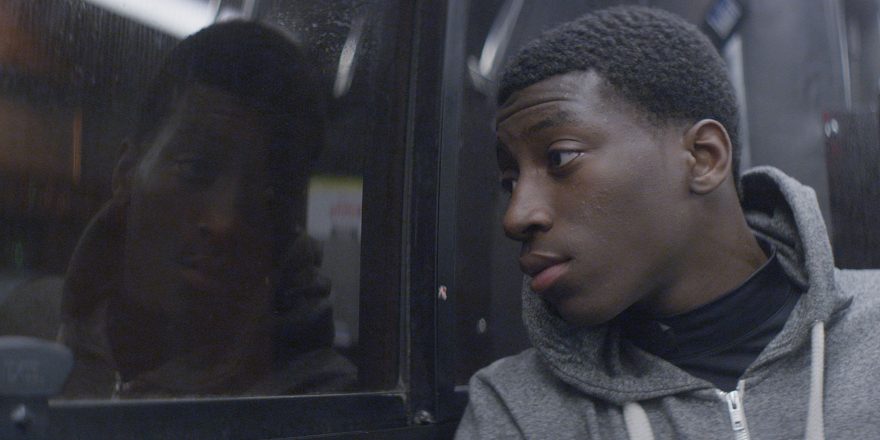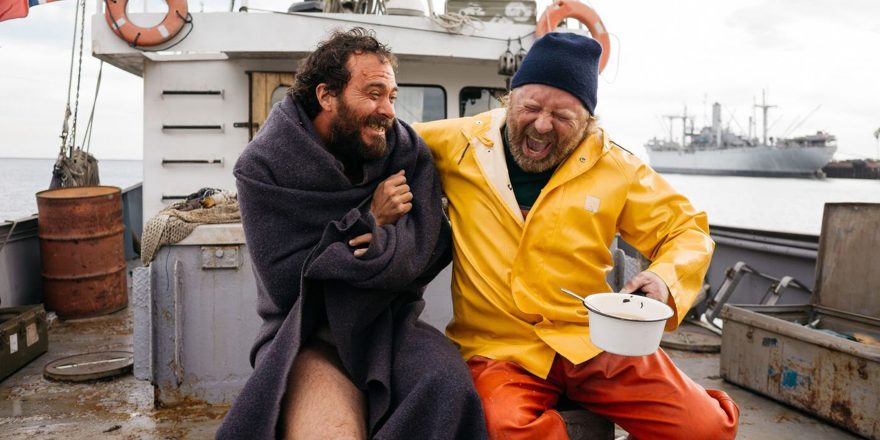The summer solstice has come and gone, but sadly the turmoil in the filmmaking industry is just getting started. And as we enter the summer season of big-budget blockbusters, we also trudge into yet another month of mass media consolidation, union strikes and industry-wide layoffs. The conflicts between the creative workforce and the corporate entities that employ them have never felt more charged. And film artists everywhere are struggling to continue creating in this volatile climate.
But amidst the upheaval of streaming giants and Hollywood at large, there is one art form in which filmmakers still rule supreme: the short film. Short films remain in an underappreciated yet largely unpoliced realm in which filmmakers can still tell the stories they want to tell.
Because short films typically don’t make money, filmmakers aren’t held to the same corporate standards of ROI for studio feature films or TV series. A short film doesn’t have to secure a distribution deal, be handled by a sales agent or formulate a PR plan. Typically, the filmmakers themselves create and submit their short films to festivals to do one simple thing – share with an audience a story they’ve felt compelled to tell.
This goal might seem simple, but I believe this practice is absolutely sacred. It is a communion between creator and audience, and it has the power to remind us all why we are in this industry in the first place. To affect people. To tell a story that is original to us. To weave a web. To share a dream.
In spite of the high-stakes capitalist climate we’re now in, I wanted to turn back to some wonderful shorts that remind me of the pure joy of creating films. The following three films feel singular and compelling in their own specific ways. These bite-size stories don’t try to pretend they are feature films. They don’t pretend to deliver the thrust of their 90-minute counterparts. But they freely dive into worlds so specific and overwhelming, they feel almost like daydreams we’ve been invited into. What a gift.
Don’t get me wrong, I believe in the future of this industry. There are incredible showrunners, writers, directors and filmmakers out there who have scores of features and shows to share. But for now, let’s shorten our attention span for just a little while and enter these three dreams together.
—-//—-
Meshes of the Afternoon
This classic surrealist short film was directed by the husband-and-wife team of Maya Deren and Alexander Hammid, though it is most often solely credited to the former. Deren initially conceived and wrote the film, so I will refer mostly to her in this section. Costing only $275 to make, this 1943 experimental film won the Grand Prix International for avant-garde film at the 1947 Cannes Film Festival and currently ranks number 16 in the BFI’s Sight and Sound poll of the greatest films of all time. The short film seems to explore a world in which reality constantly eludes the viewer’s grasp, and due to its avant-garde nature, its meaning is widely debated.
The visual journey of Meshes of the Afternoon is somewhat circular. The film begins with a disembodied mannequin hand placing a flower on a path. A woman (Deren) picks up the flower on her walk home. She takes out a key and enters the house to find various everyday household objects such as a knife, a phone and a phonograph around the home. Then she falls asleep in a chair by the window and dreams of a hooded figure with a mirror for a face coming up the path to her house. The rest of the film seems to repeat itself, adding dreams on top of dreams. The hooded figure continues to stalk through the house. Deren multiplies into various versions of herself. Finally, a man (Hammid) wakes the sleeping Deren and takes her upstairs, but she quickly realizes he might be the masked man who haunted her dreams. She tries to fight him to save herself. But in the end, we find Deren’s body in the chair where she once napped, dead and bleeding from knife wounds. Were her dreams trying to warn her of an impending danger in her home? Or is it futile to try to place logic onto this film at all?
Addressing the film’s approach, Deren said that Meshes of the Afternoon “is concerned with the interior experiences of an individual. It does not record an event which could be witnessed by other persons. Rather, it reproduces the way in which the subconscious of an individual will develop, interpret and elaborate an apparently simple and casual incident into a critical emotional experience.”
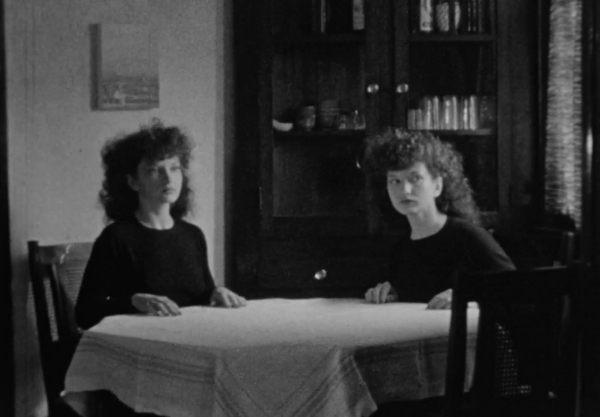
What Deren was talking about is a purely subjective cinematic experience and a lowering of the veil between artist and audience. Instead of showing an event or a story as it might play out in waking life, she opens her mind and her psyche for us to experience. It is an intimate gesture and a communion between filmmaker and audience. This profound insight is often overlooked in larger, more commercial projects, where studios prioritize story comprehension and merchandising over artistic expression. Comprehension and understanding are overvalued in the realm of cinema. And this short film proves that even if you don’t understand what is happening, you can’t help but feel something while watching it.
Deren created a world in which reality is but a walking shadow and dreams might impossibly provide the key to a deeper knowledge. But the joy of Meshes of the Afternoon is that we can’t reason our way through it. Not completely. But cinema isn’t an essay we have to turn in to a teacher. And, perhaps contrary to popular belief, we don’t have to intellectually understand everything we watch. We simply have to subjectively feel what Deren has shared with us and experience the film ourselves. And, in doing that, we are perpetuating the reason cinema exists at all.
—-//—-
Sudden Light
In 2020, writer-director Sophie Littman achieved one of the greatest cinematic representations of impending grief I have ever seen. Littman premiered her film Sudden Light at the Short Film Competition at Cannes and introduced the world to a liminal allegory that explores mortality, grief and the pain of growing up, all within the span of only 15 minutes. This deceivingly simple narrative was able to affect me more than most feature films I’ve seen. And while it goes without saying that I am a subjective individual and I come to film analysis with my own past and vulnerabilities, I honestly believe Sudden Light can speak to all audiences.
Like the short stories of Raymond Carver or the novels of Ernest Hemingway, the tactile world and seemingly simple story structure of Sudden Light reveal a complex psychological undercurrent that lingers long after the credits roll. To this point, Littman’s cinematographer, Nick Morris, once stated, “When Sophie came to me with the script it was clear she wanted to achieve something that started in naturalism and realism, but then really dug into the strong, subjective experiences of the characters in quite an abstract way.” And after all, filmmakers must rely on two basic things to tell their stories. They must ask themselves, What will the audience see? And what will the audience hear? These questions might seem blatantly obvious, but this is the jumping-off point for everything else that follows.
On the surface, what we see and hear in Sudden Light all seems quite simple. Sisters Mia, 16, and Squeeze, 12, walk their dog Jack around fields near their home in the English countryside. As they walk, they discuss their hospital-bound father and their plans to go visit him once his tracheotomy is removed. The sisters get lost in the field, find each other again and follow the setting sun home before dark. But there is far more than meets the eye in Sudden Light. The real artistry lies beneath the surface, simmering in romantic and dread-inducing 16mm that peels away layers of existential dread. Sudden Light forces us to look beneath the surface to see the true terrors at its heart.
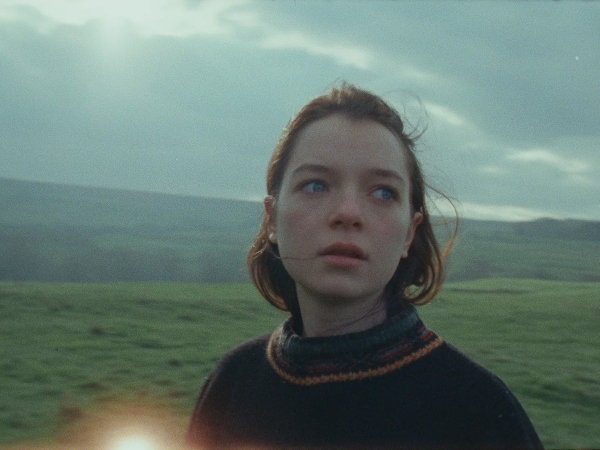
The promise of grief lingers in Mia’s voice as she petulantly sidesteps the topic of their father. The impending responsibility she will take on after her father’s death seems to weigh heavier and heavier as she walks with her younger sister. Mia becomes separated from Squeeze and finds Jack the dog with a strange man in the field. And it’s at this point Sudden Light takes on a mythic quality reminiscent of the work of Ingmar Bergman or Andrei Tarkovsky.
In an uncanny close-up, the strange man tells Mia that her father might not have his tracheotomy removed after all. Mia studies the man’s face, unsure how he might know this information. But it soon dawns on her that this man might not be a man at all. Through the subtle performance of Esme Creed-Miles, we start to realize this man might be death himself, lurking the countryside in search of his next soul. Mia flees from the man, though she can’t escape the knowledge that, in that very moment, her father might be dying. The countryside becomes a map of her subjective experience, twisting in confusing circles and leading her astray. The idyllic hills begin to shift around her, turning into labyrinthine liminal spaces full of dread and confusion. A dark wooded area and a swampy pond appear, hellish and dread-inducing somehow. Maggots and worms churn in the soil, reminding us that Mia’s father might soon be in that very soil.
Losing a parent is a gut-wrenching ordeal, and the world seems to topple onto itself, turning insidious and menacing as an uncertain future looms. Thankfully, the film gives us comfort in the end, reuniting Mia with her sister and safely returning the girls home before dark. But this poetic meditation on grief provides a nuanced psychological journey that reminded me of my own journey through losing a parent. And while that process is never easy, it can be a profound and transcendent experience that fundamentally deepens our remaining relationships and gives us perspective on our own journey ahead.
—-//—-
Möbius
In 2017, writer-director Sam Kuhn world premiered his astounding short film Möbius at the Cannes Film Festival’s Semaine de la Critique. This “moth eaten tale of magic and mutation” spins a paradoxical fairytale that is at once poetic and achingly familiar.
Watching Möbius is the closest I’ve felt to remembering my high school experience in all of its melancholic glory. You remember it too, don’t you? That confusing, dizzying, heartbreaking joy and terror of being young. Of love at first blush. Of broken and healed friendships. And of secrets and hidden worlds. We all know this language because it was once ours, but in the process of growing up we might have shed this reality in favor of a more practical approach to life.
Sam Kuhn takes us back to that place in Möbius. Through the voice of his main character, Stella, he whispers to us about the subjective experience of young love. “I was no longer able to tell if I had actually been in love or just in love with the idea of love,” Stella admits. But regardless of the object of her affection, the point is the journey from love to heartbreak to poetic closure. It doesn’t matter if things happened exactly the way we see them in this film. It matters that this is how it felt. Images of a dancing janitor, a wolf stalking around in high-school hallways and a heart attached to a bunch of balloons all mean something to me because they speak to a deeper truth. A truth of alienation and tragic poetry. A truth of love and friendship and excess. Of life itself.
The visual approach is arresting, as is most of Kuhn’s work. There is a joyful melancholy to the visual language of Möbius, which simmers in gorgeous 35 mm. The blue hour of teenage love is simultaneously melodramatic and undeniably honest. It is in this dance of poetry and awkward humanity that Kuhn finds his singular voice.
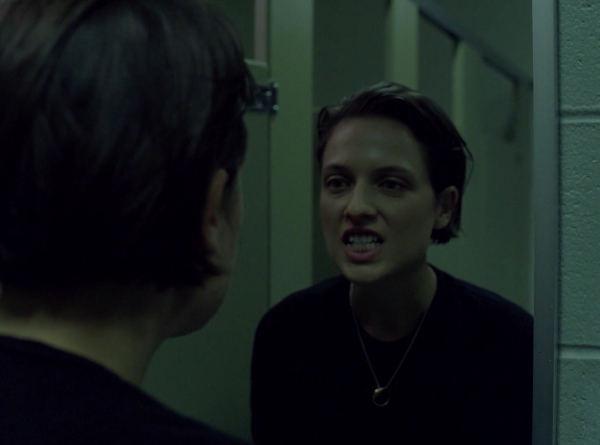
But Kuhn also does something far more nuanced than simply showing us a beautiful short film. He breaks into his misty, dreamlike motifs and grounds them with relatable, human moments. As the film progresses in a collage of misty images, Kuhn consistently breaks his poetry with honest performances and moments we might collectively remember from high school. A kid running past you in the hallway, kicking the walls for no reason at all. The day you were bullied and had to go ask a teacher for help. A longing gaze at a former friend and the silly face you made, hoping they would smile. In some form, I believe all of these moments exist in a kind of collective memory, which is why the film is so affecting and effective. That cinematic acknowledgment comforts me in a way that’s hard to describe. But luckily, I don’t have to. I simply have to fall under the spell of this paradox and experience it in my own subjective way.
You might think this Cannes short film had a massive budget to accomplish such artistic feats. But Kuhn, who was kind enough to correspond with me about the film, assured me there was no such budget available to him. He described his process, saying, “Financial restrictions meant that everything had to be first or second take and we had to move quickly, which in the end was a blessing as it kept the energy high and everyone enthused. With more money I plan to continue to work in this athletic way. I’m very well acquainted at this point with how to make things frugally – most of the European shorts we were competing against at Cannes had 10 to 20 times our budget.” This is fantastic insight for independent filmmakers looking to create their own work. The inherent financial restrictions that tend to come with creating short films can sometimes push artistry further, developing skills and workflows that might not have existed before.
Furthermore, it’s not money that makes great cinema, anyway. I’ll end with one final quote from Kuhn, who shared some inspiring words for filmmakers everywhere. These words are especially stirring during this time of turmoil in the industry, when it might be easy to lose perspective. Kuhn explained, “It’s important to remember that great things are often made with no money and in the realm of art it’s never money which motivates anything at all. Money is just a system of oppression and liberation. Will, inspiration, joy, friendship, faith, love, etc. These are the ingredients which make art. So I don’t really view financial restrictions as restrictions at all, more like parameters within which the work may exist.”


